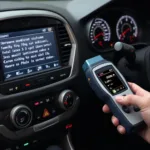Converting an OBD2 reader to OBD1 functionality is a common quest for car enthusiasts working on older vehicles. This guide explores the intricacies of bridging the gap between these two diagnostic systems, offering solutions and insights for seamless vehicle diagnostics.
Understanding the OBD1 and OBD2 Divide
Before diving into conversion methods, it’s crucial to grasp the fundamental differences between OBD1 and OBD2. OBD2, standardized in 1996, utilizes a universal connector and digital communication protocols, making it easier to diagnose various vehicle makes and models. OBD1, on the other hand, predates this standardization, resulting in diverse connectors and manufacturer-specific communication methods. This lack of uniformity makes converting an OBD2 reader to OBD1 a more complex undertaking than a simple plug-and-play solution.
Can You Truly Convert an OBD2 Reader to OBD1?
The term “convert” can be misleading. While you can’t physically transform an OBD2 reader into an OBD1 scanner, you can achieve OBD1 functionality by using adapters and specialized software. This involves using an adapter to bridge the physical connection between the OBD2 reader and the OBD1 diagnostic port. Furthermore, specific software is required to interpret the data retrieved from the OBD1 system, as the communication protocols differ significantly.
Methods for Achieving OBD1 Functionality
Several methods allow you to access OBD1 data using an OBD2 reader:
- OBD1 Adapter Cables: These cables connect your OBD2 reader to the vehicle’s OBD1 diagnostic port. Different adapter cables are required for various vehicle makes and models due to the lack of standardization in OBD1 systems.
- Software Solutions: Dedicated OBD1 software, often combined with an adapter cable, translates the manufacturer-specific codes into a readable format on your OBD2 reader or computer.
- All-in-One OBD1/OBD2 Scanners: Investing in a scanner that supports both OBD1 and OBD2 protocols offers a more streamlined approach, eliminating the need for separate adapters and software.
 OBD2 to OBD1 Adapter Cable
OBD2 to OBD1 Adapter Cable
Choosing the Right Method for Your Needs
The best approach depends on your specific requirements. For occasional use on a single vehicle, an adapter cable paired with free or low-cost software might suffice. However, for professional use or working with various older vehicles, investing in an all-in-one scanner is a more efficient and reliable solution.
What are the common OBD1 codes?
OBD1 codes vary greatly depending on the vehicle manufacturer. Consult your vehicle’s service manual for specific code definitions.
Where is the OBD1 port located?
The location of the OBD1 diagnostic port differs between makes and models. It is usually found under the dashboard, in the engine compartment, or behind a panel. Refer to your vehicle’s service manual for its exact location.
Conclusion: Bridging the Diagnostic Gap
Converting an OBD2 reader to access OBD1 data requires adapting to the older system’s complexities. By using the right adapter, software, or an all-in-one scanner, you can effectively diagnose both OBD1 and OBD2 vehicles, ensuring comprehensive vehicle maintenance and repair.
FAQ: Converting OBD2 to OBD1
- Can I use any OBD2 reader with an OBD1 adapter? Most OBD2 readers can be used with an appropriate adapter, but compatibility with specific software is crucial.
- Are OBD1 adapters universal? No, OBD1 adapters are vehicle-specific due to variations in OBD1 systems.
- What is the cost of an OBD1 adapter? Adapter prices vary depending on the vehicle make and model.
- Where can I find OBD1 software? OBD1 software can be found online or through specialized automotive tool suppliers.
- Is an all-in-one scanner worth the investment? For frequent use or working with multiple older vehicles, an all-in-one scanner is a worthwhile investment.
- What are the limitations of using an adapter? Adapters may not support all OBD1 functions and can be limited by software compatibility.
- Can I diagnose all OBD1 vehicles with a single adapter? No, different adapters are often required for different vehicle makes and models.
Need further assistance? Contact us via WhatsApp: +1(641)206-8880, Email: [email protected] or visit us at 789 Elm Street, San Francisco, CA 94102, USA. Our 24/7 customer support team is ready to help.
